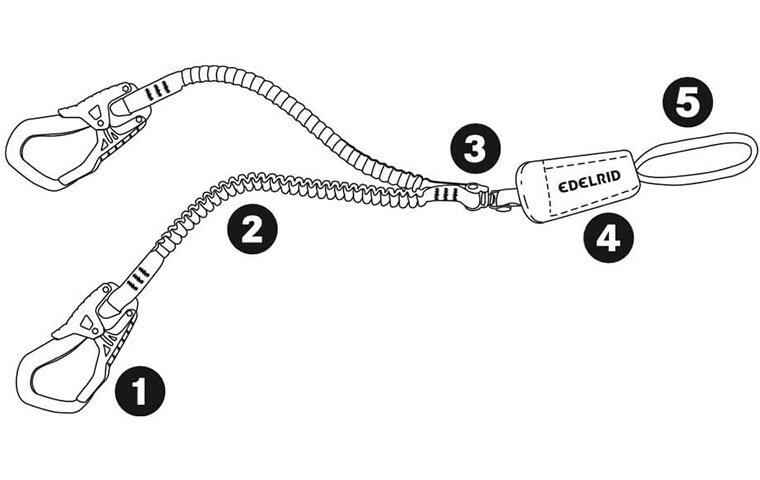The via ferrata as an easy access to the vertical enjoys great popularity. Here, the via ferrata set serves to provide safety in the event of a fall. In the following, we will look at how a via ferrata set works and what a fall looks like in practice.
HOW DOES THE SHOCK ABSORBER OF A VIA FERRATA SET WORK?
A via ferrata set is made of carabiners that are hooked to the steel cable, elasticated arms that allow for freedom of movement, a shock absorber that dampens the forces in the event of a fall and the tie-in loop that is used to make the connection to the harness.

1. Via ferrata carabiners | 2. Elasticated arms | 3. Swivel | 4. Energy absorber | 5. Tie-in loop
The via ferrata climber ascends along the steel cable and always attaches at least one carabiner. If he falls, he falls down to under the last via ferrata anchor. This is why the most dangerous moment is, when the climber reaches the anchor point and changes the carbiners into the next part of the steel cable - it's the moment with the potentially biggest fall height. Via ferratas must be constructed according to the European standard EN 16869 in such a way that the fall height is no more than five metres. This requirement is tested in the standard for via ferrata sets EN 958.

The core element of a via ferrata set is the shock absorber. It lengthens the braking distance and thus reduces the forces during a fall. The most common construction of shock absorbers is a progressive-tear energy absorber, which consists of two webbings specially sewn together to allow progressive tearing in case of a fall.
This construction must be tuned very precisely. According to the standard, the shock absorber must not tear open up to 1.3 kN for example when resting. On the other hand, it has to dampen the impact force on light persons (40 kg) to less than 3.5 kN - for a fall with a height of five metres. The same set also has to absorb a five-metre fall of a 120 kg person within 2.2 m and with a maximum impact force of 6 kN. The dynamic requirements are tested according to the standard with a guided drop mass.
The standard ensures that in the event of a fall into a via ferrata set, the chance of life-threatening injuries from the braking process is small and that the set has sufficient strength.
A real fall at a via ferrata is usually not a free fall, but a fall on rocky terrain. It can be divided into three parts:
- The via ferrata user falls along the wire rope to the next anchor until the load arms of the via ferrata set are tensioned. Thereby contact with artificial climbing aids such as iron rungs, pegs, carved steps, and ladders or ledges in the fall line is possible.
- The shock absorber tears open and breaks the fall.
- The via ferrata climber hits the rock face.
If you keep this in mind, it becomes clear that a fall into a via ferrata set has a very high potential for injury. A via ferrata set should therefore always be treated as emergency equipment. Consequently, it is important not to move at the fall limit when climbing on a via ferrata and to additionally belay children or weaker persons in vertical passages with a rope to rule out a fall.
